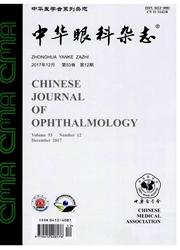

 中文摘要:
中文摘要:
目的观察体外培养的人骨髓间充质干细胞(hMSCs)移植到碱烧伤的兔角膜表面后,干细胞的成活、迁移和分化情况。方法采用NaOH溶液制作兔角膜碱烧伤模型,1个月后将培养有hMSCs的羊膜缝合到碱烧伤的兔角膜表面,以羊膜作为对照组,在裂隙灯显微镜下观察角膜的临床改变。术后1个月,摘除眼球,石蜡切片,苏木素-伊红(HE)染色观察角膜组织结构的变化,并进行抗人核抗体和细胞角蛋白12(CK12)的免疫组化染色以观察hMSCs的分布和分化情况。结果兔眼碱烧伤1个月后,角膜表面和基质层均可见大量血管,角膜呈瓷白色混浊,表面粗糙干燥,出现大量杯状细胞。hMSCs移植1个月后,角膜表面粗糙程度减轻,新生血管略有减少,但是角膜混浊未见明显改善,角膜表面杯状细胞消失;角膜表面和基质浅层存在抗人核抗体染色阳性的细胞;角膜表面细胞CK12染色阳性,而基质层未见CK12阳性细胞。对照组在羊膜移植1个月后,角膜状况较移植前无明显改善,角膜表面仍可见杯状细胞,角膜各层均未见抗人核抗体和CK12染色阳性的细胞。结论hMSCs移植到碱烧伤兔角膜表面后,能够成活并向角膜基质迁移,未发生移植排斥反应。hMSCs由于所在部位不同,可以在周围组织的诱导下向不同方向发生分化,角膜表面的细胞向角膜上皮细胞分化。而基质层中的细胞未分化为角膜上皮细胞。移植后角膜表面结膜化程度有所减轻。
 英文摘要:
英文摘要:
Objective To investigate the survival, migration and differentiation of the cultured human mesenchymal stem cells derived from bone marrow(hMSCs) after transplanted onto the alkaline burn rabbit cornea. Methods Alkaline burn on rabbit corneas was induced with NaOH solution. One month later, hMSCs cultured with a feeding of amniotic membrane were transplanted onto the surface of alkaline burn rabbit corneas. Amniotic membrane alone transplantation was used at the same time as control group. One month after transplantation, the changes of corneal morphology were analyzed by clinical observations and HE staining. Immunohistochemistry was carried out with the antibodies against human nuclei and cytokeratin 12 to investigate the distribution and differentiation of hMSCs. Results The rabbit cornea became totally opaque one month after alkaline burn. Blood vessels could be seen within the superficial layer and stroma. The surface of cornea was rough and dry. There were many goblet cells found in the corneal epithelial layer. One month after transplantation of hMSCs, the surface of alkaline burn cornea became smoother. The amount of the new blood vessels of the cornea reduced and the goblet cells disappeared. Antihuman nuclei antibody staining showed positive cells on the surface layer and superficial stroma while cytokeratin 12 positive cells were only present in the epithelium layer. In the amniotic membrane transplantation control group, no clinical improvement of the cornea was found. Goblet cells were still seen on the corneal surface. Both anti-human nuclei antibody and cytokeratin 12 staining were negative. Conclusions hMSCs survive and migrate to stroma after transplanted onto the surface of alkaline burn rabbit cornea. No rejection is detected, hMSCs on the corneal surface differentiate to corneal epithelium, where those migrated to the stroma differentiate to cells other than epithelium, hMSCs transplantation decrease cornea conjunctivization after alsaline burn.
 同期刊论文项目
同期刊论文项目
 同项目期刊论文
同项目期刊论文
 期刊信息
期刊信息
